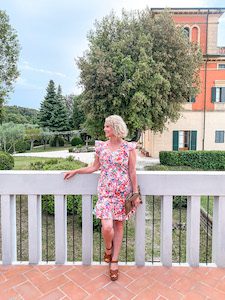One of the most beautiful parts of the wedding is the flowers. They add color, texture, and fragrance to your big day! Although you may know the names of a few blooms, there are several common types of flowers to use. You may find a new favorite in our list of eight.
If you aren’t a florist, chances are the very thought of putting together a bouquet will stress you out. While a good florist can help you make decisions, it’s good to know what flowers you like. You also need to determine what colors you want. To help make things easier, we’ve got the skinny on the most common types of flowers for your wedding.
Common Types of Flowers for Weddings
1. Roses are a timeless choice.
Roses are a classic for weddings as a symbol of both love and purity. While roses may be a bit traditional, there are over a hundred different types of roses. Each varying in color and size.
Roses bloom on and off throughout mid-spring to fall, making them perfect for summer weddings. These wedding flowers also come in over 20 colors ranging from salmon and red to lilac and green.

2. Anemone adds impact to your bridal bouquet.
If you are looking to make a bold statement with your floral arrangement, anemones are a great option! The bold black center of the flowers and white exterior make them excellent for vintage or non-traditional weddings.
These flowers primarily bloom in the winter. Therefore, they’re a fabulous cold-weather wedding flower choice.

3. Ranunculus are common types of wedding flowers that give softness to your centerpieces.
These flowers are an excellent option for those looking for a bright bouquet. Ranunculus flowers have closely formed petals. Therefore, they look stunning when paired with everything from roses to succulents.
These flowers are perfect for brides wanting a more rustic and handcrafted look or for an elegant wedding.

4. Peony blooms are large, statement flowers for your wedding bouquets.
Peonies are fragrant, lush flowers that give a very romantic vibe with their mounds of fluffy petals. Peonies look best when paired with cream-colored flowers as well as eucalyptus.
While these flowers look stunning for a spring or summer wedding, you can find them in shades of mahogany or yellow to accent a fall wedding. In Virginia, these bloom primarily in May, which can be economical for spring brides.

5. Hydrangea comes in a variety of pastel colors.
Hydrangeas are most known for being flowers with very full heads. Even using one or two hydrangeas in your bouquet or a centerpiece can fill a vase or bouquet nicely.
In pale pink or white, these flowers can look exquisite and beautiful. However, bright blue and deep purple are additional gorgeous color options. If you have a June or July wedding in Virginia, you may be able to have these freshly picked locally.

6. Dahlia are types of common wedding flowers that add a charming, full element to bouquets.
Dahlias are very similar to peonies and hydrangea flowers. Therefore, they can bring a lot of charm to your wedding bouquet. Dahlia flowers have round petals that make a dramatic statement in any bouquet where they are placed.
When paired with a loose bundle of greenery, these beautiful flowers can make your bouquet look elegant and rustic.

7. Myrtle gives a nod to British royal wedding bouquets.
Myrtles are the ideal summer flower with the blooming season starting in mid-may and early June. Crepe Myrtles come in various colors, from white and purple to shades of pink and red.
As a nod to Queen Victoria’s 1840 wedding, myrtle is included in all British royal bouquets. These blooms also pair well with heavy petal flowers such as peonies, ranunculus, and roses.

8. Hellebore adds a subtle, leafy texture to wedding bouquets.
Hellebores are a versatile flower coming in nearly any color you’d like. They can be found in tones, such as purple, white, green, and even pink. When adding these to a bouquet or decor piece, try to aim for flowers with blue and purple in them.
However, green hellebores add an element of a leafy-looking flower, which adds interest and bulk to a bouquet.

When it comes to flowers, there will be no shortage of choices for your big day. By learning a little more about the most common types of flowers for weddings, you can select ones that are uniquely you. After the big day, preserve your bouquet to have your flowers close by forever.
Love these common types of flowers? Save it!

Photos: Ilona Kovalkova, Zoe Schaeffer, Evie Fjord, Rebecca Lee, Annie Spratt, Karolina Grabowska, Lisa Marie
























